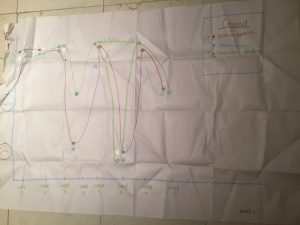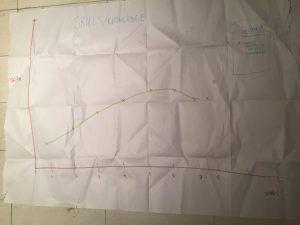Introduction
Through this experiential learning project we have had the opportunity to experience first-hand many of the topics we have discussed in class. While surveying food programmes in the Downtown Eastside (DTES) we have seen the effect that gender, race and age all have on food security. There have been many significant moments that we have experienced while participating in this project. An overarching theme we have experienced is the complexity of food security and how vastly different the definition of food security is when you see it on paper and believe that it can be easily achieved with adequate funding and support, when in reality, it is much more complex than any written definition could portray. Each food programme has different assets and areas that improvements could be made.
Weekly Objectives:
- Compile all of our qualitative data in order to begin forming information sheet
- Begin preparation of infographic
- Start to work on final report
Achievements:
- Completion of all surveys
- We designed a time frame that fits all team members schedules in order to complete upcoming assignments
Moments of Significant Change


What
Our group has contributed to completing our community project over the term and throughout we have made achievements. The most challenging part throughout this term that we have noticed is getting good grades on our blogs. For the past two blogs, we got pretty low marks for our first submission. Before submitted them, all the group members went through the text to ensure the instructions were being followed. However, the marks we got were not at all what we were anticipating and we found this could have been due to following the instructions on the LFS 350 website rather than the rubric found on Canvas, which we had not been aware of due to following the website instructions only.
So What
Our group recognized that we need to take it seriously and find out how we could improve for next blog submission. Due to the feedback, we found that the biggest problem was even though we followed the instructions posted on the LFS website, we still ignored the rubric on Canvas. In addition, other aspects such as grammar, explanation and structure needed more effort put into it.
Now What
As we found out where we need to focus on to make improvements, before we write, we as a group discuss the material for every part together. When we write the blog, we follow both the instructions and rubric carefully. After everyone has contributed to the blog, each team member has the chance to proofread it and edit before submitting it. We hope we will get better mark after recognizing our mistakes and improving our blog writing techniques.
Linkages
Something our group noticed as we went to various Downtown Eastside (DTES) food programs is that most of them depend primarily on donations, making it difficult to create daily options such as: dairy or sugar alternatives, gluten-free, whole grains, etc. We gathered that what they serve is generally what they receive from donors, leaving many of the programs without the choice to serve specific foods for individuals with dietary restrictions. One paper we read for class, “Learning to see food justice,” had a quote saying “Everyone wants good food,” the author goes on to talk about how eating nutritious foods is not as easy as it may seem for some people in certain circumstances (Dixon, 2014). This stood out to me because this perspective is something we continued to encounter while talking to various food programs in the DTES; many of the kitchen staff said they would have loved to give these options everyday but it just was not possible because they either didn’t have the money to provide these options regularly or their donations were not made-up of these foods primarily. There were a few food programs that did have donors that offered such foods and products but the majority we found did not have the financial means to gets these foods or their donations did not fit this criteria, making it even more difficult for people with dietary restrictions to get access to certain foods.
Another moment that struck us as significant and further exemplified how multifarious the definition of food security is occurred while we were in a facility waiting to interview a staff member. A woman came up to us wondering if we were city/government workers that were evaluating the program. We told her we were from UBC but she proceeded to tell us everything she wanted to in the hopes that we could in some way express her comments to city/government representatives. A key concern she mentioned was that when she came to the facility to get food and access its food program, she did not feel safe as there was frequent fighting amongst individuals accessing the program and that her belongings were often stolen. This dilemma highlights the ongoing issue of food insecurity in the Downtown Eastside and the multiplicity and complexity of achieving food security in its completeness. While having access to nutritious food is part of the definition of food security, it alone, does not constitute an individual being food secure, as to be food secure someone must have access to safe and nutritious food. Thus, accessing food from a facility where the individuals feels unsafe does not fulfill the definition of food security in its entirety. While there are many food programs that offer food, if individuals do not feel safe while eating they will be deterred from accessing and using available food programmes.
In one food programme we surveyed, the worker explained to us the history of how the program had evolved and what changes had been made to ensure mothers were getting adequate access to nutritious foods. During the onset of the program, they allowed individuals to take the food and leave, unfortunately, over time, they noticed that many of the mothers who were accessing their programs and seemingly taking the food provided, were not actually consuming the food. The women, many of whom were either pregnant or lactating mothers (both of which have increased nutrient requirements) were often taking the food and giving it to their partners. This behaviour emulates a vital current conversation occuring within the food system, the relationship between gender and food. This is further highlighted in the interview with Dr. Kate Cairns, where she talks about the relationship between food and femininity and a woman’s desire to be able to feed her family. She explained that if a women is unable to feed her family she feels as if she has ‘failed’ and that the “stakes are so high … around femininity and food, … [and] that this was a really potent site of emotion” (Cairns, 2016).
As mentioned, the author speaks about the importance of providing women with safety and supportive environments, two things of which this food program has done an excellent job of ensuring for the women that access its program. The changes the program made requires women to eat the meal in the facility, to ensure that they are consuming the food themselves, the program also allows the mother to bring their partner and or children in with them as long as the partner is respectful and polite. This progressive and socially aware program has begun to breakdown the gender inequalities seen in the food system, by creating a safe and inclusive space for women to gather.
Graceful Dismount:
So far our team has worked very hard at surveying numerous organizations and completing our assignments/blog posts. We have felt satisfied with how the surveys had gone but at times very discouraged with the marks we have received for our assignments/blogs. Through these emotions we have realized that positivity, determination, and teamwork are crucial for this project and most likely other current and future aspects of our lives. At this point we have completed all of our surveys and are working to compile all the qualitative data we have gathered. To finish off this course we plan to time manage and start our final report early as the end of the year can be quite hectic. With only one month left of our project, our strategy is to continue working hard, supporting each other, and staying on top of our project. This will ensure we finish the term with a sense of accomplishment and submit a project that we as a team are proud of as well as beneficial for the DTES Neighbourhood House and the DTES community. Furthermore, we will aim to stay on task, complete our assignments early when possible, strictly follow assignment rubrics, continue to stay positive, continue to communicate within our group effectively, and continue to be flexible with any obstacles we may come across. We are excited to analyze our data, create a informational fact sheet, and complete our project on a positive note.
Conclusion
Each program we surveyed has different assets as well as challenges. Throughout our survey we saw first-hand different aspects of food security and the variation in the food that is provided to residents of the Downtown Eastside. Each food service provider offers a unique program to the community, varying in the number of meals per day that they offer as well as the content of what they provide. All these organizations play a vital part in the lives of the residents and even though some may not provide the most nutritious foods they all expressed the benefits that they do provide and are aware of possible improvements that can be made. It was an amazing experience to witness the impacts that these organizations have on the lives of so many and to better understand food justice and security of the Downtown Eastside Community of Vancouver.
References
Dixon, B. A. (2014). Learning to see food justice. Agriculture and Human Values, 31(2), 175-184. 10.1007/s10460-013-9465-3
Cairns, D. (2016). 5: Food & Femininity. Racist Sandwich. Retrieved 11 March 2018, from http://www.racistsandwich.com/episodes/2016/6/29/e5-food-femininity-with-dr-kate-cairns